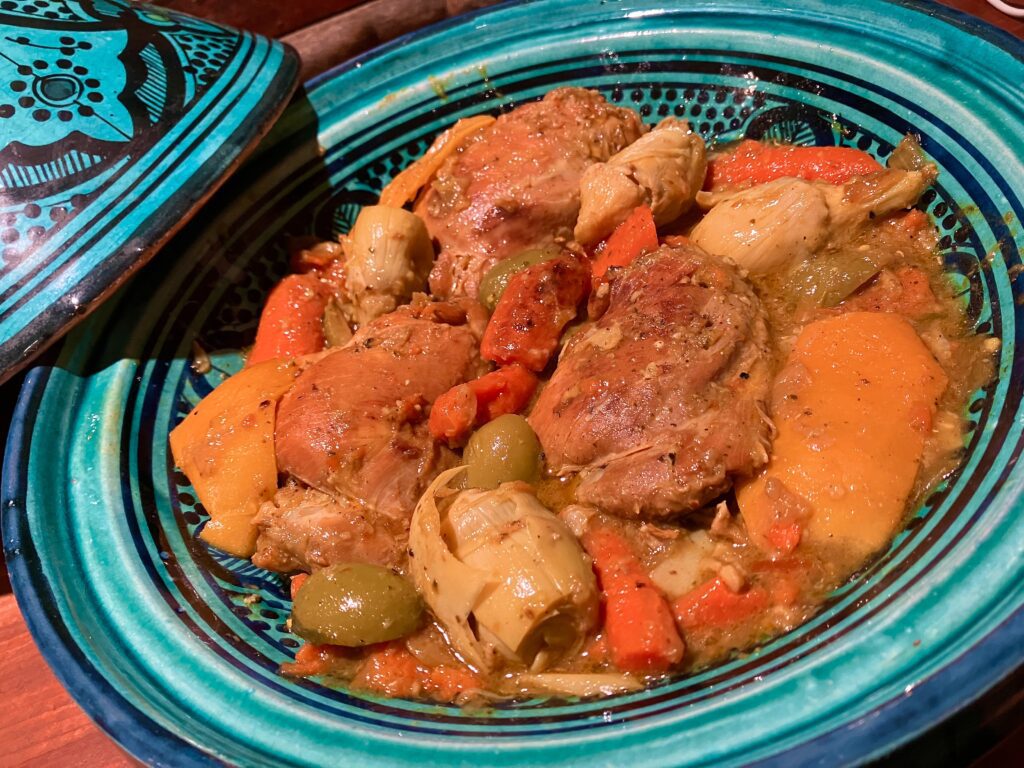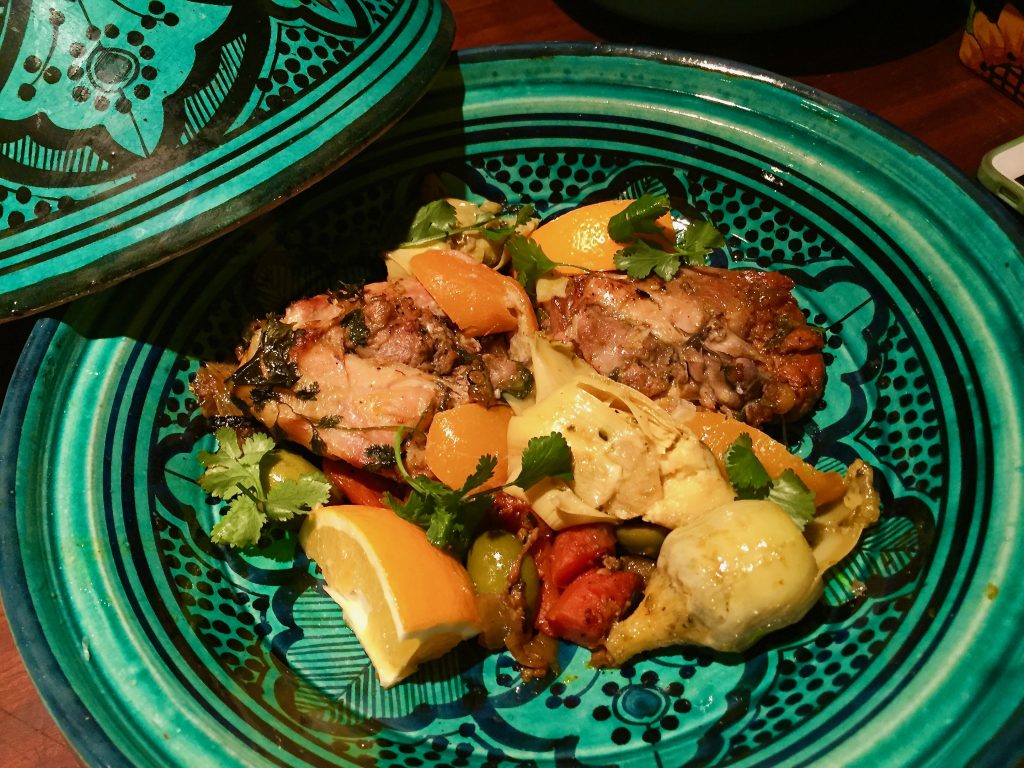
This is one of Rebekah’s signature feasts and one of our absolute favorites. Everything about it is sumptuous and savory and exotic, even the clay vessel it’s made in. The word “Tagine” is used for both the vessel and the meal itself, and a Tagine can be made in a myriad of ways, depending on the available ingredients. This recipe calls for chicken but we have also made it with rabbit and lamb, both of which are fabulous. Rebekah cans the Meyer lemons in wide mouth pint jars and stores them in the refrigerator for about six months, or up to a year, before use.
Over that time, as they preserve, the Meyer lemon skins become butter soft and creamy, and the salted juices thicken, developing an ethereal but penetrating aromatic liqueur which has the consistency of syrup. Along with the saffron, green olives, ginger and roasted peppers, they fill the house with an intoxicating fragrance.
The Tagine is uniquely conical shaped, which allows the steam from the cooking spiced meats and vegetables to rise, condense, and then fall back into the bubbling meal. This intensifies the flavors as the meats simmer in their own juices.
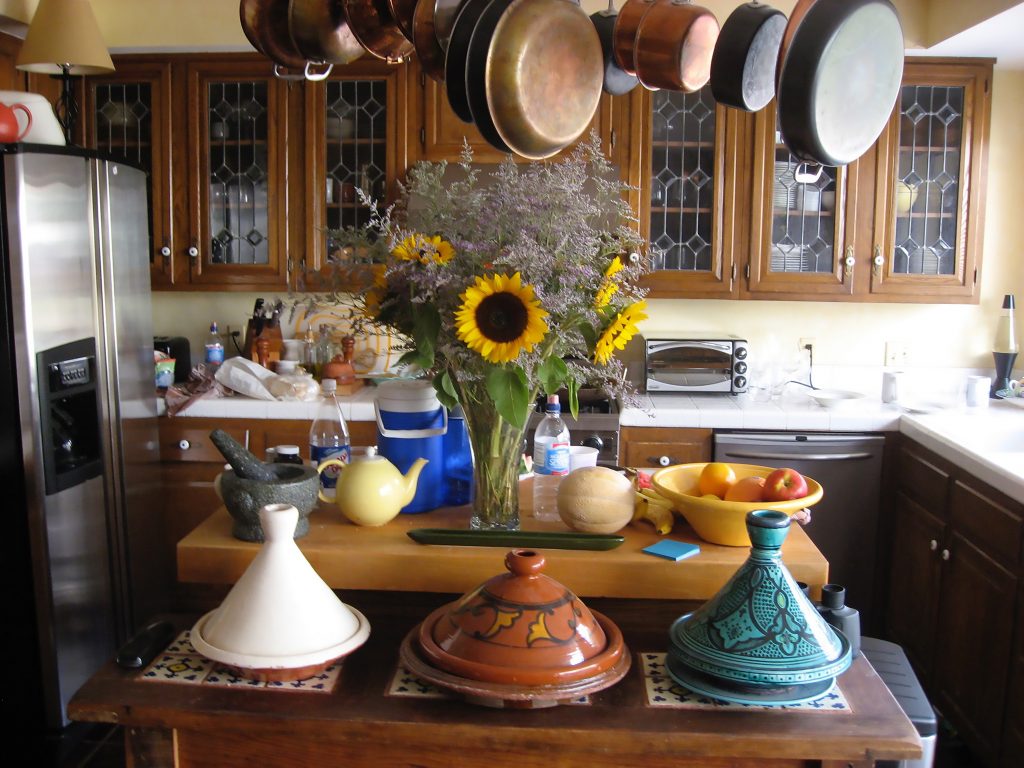
Ingredients
1 pint jar preserved lemons, with 3 to 4 Meyer lemons inside, along with the liqueur of salted lemon juice
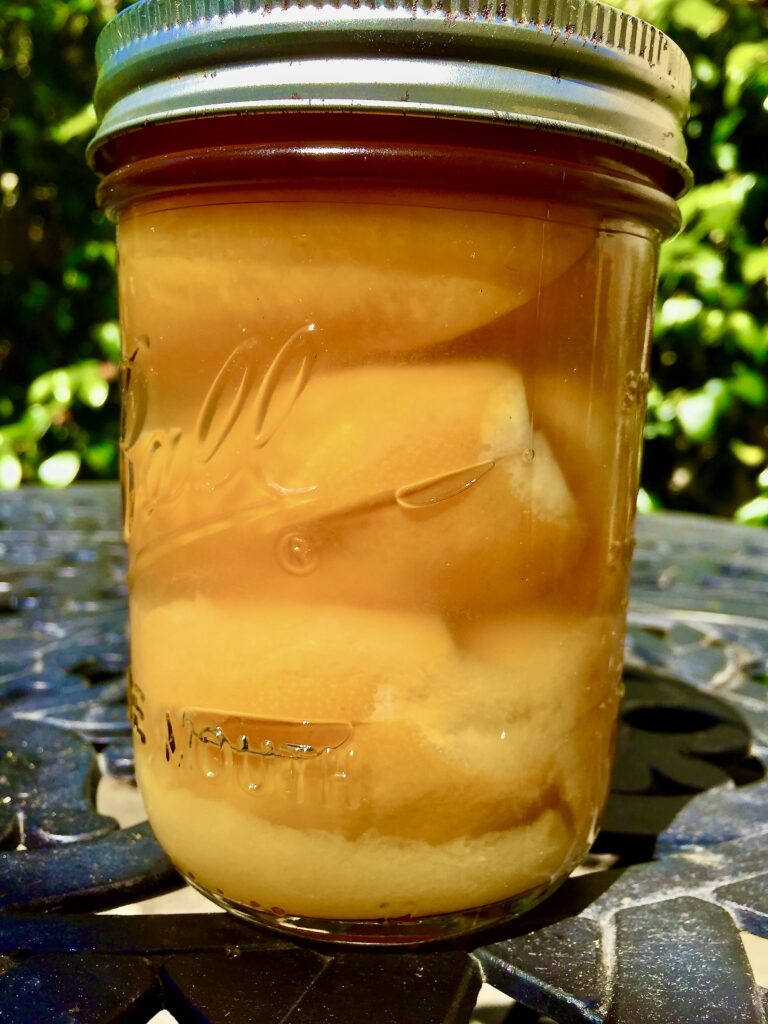
10 chicken thighs, skin off, bone in (we use Smart or Mary’s brand, free range, air chilled)
4 cups rich chicken bone broth (we boil down the bones of a whole roasted or rotisserie chicken until we have a thick intense broth)
2 cans artichoke hearts (we use small whole ones)
3 poblanos (sometimes incorrectly called pasillas), roasted till charred and peeled
3 serrano peppers, roasted till charred, then peeled
12 to 15 medium carrots, cut into 2 inch segments, with the thicker pieces also cut lengthwise
1/2 stick butter, (or 1/4 stick butter and 1/4 cup duck fat)
1/4 cup olive oil
1 fresh lemon
2 medium onions, chopped
4 inches ginger, grated
10 cloves garlic, crushed
1 big pinch saffron (after a gentle dry pan fry to toast slightly, crush them with your fingers, it should be at about 1/2 teaspoon, but not a full teaspoon, it’d be too bitter)
1 1/2 cup green Queen olives, about 20, cut in half (or Castelvetrano olives)
1 bunch Italian parsley
1 bunch cilantro
1 teaspoon smoked Spanish paprika
1 teaspoon sugar or 1 tablespoon of mirin
Salt to taste, (you won’t need much because of the salt in the preserved lemons)
1 teaspoon black pepper, to taste
Prep work
Soak the Tagines in warm water for several minutes.
Roast the poblano and serrano peppers, charring the skins, peel, remove seeds, and place in a small food processor. SLOWLY pour in 1/4 cup olive oil until it blends together into a paste.
Place the grated ginger and the crushed garlic in a mortar and pestle and blend them into a paste using 1 tablespoon of water.
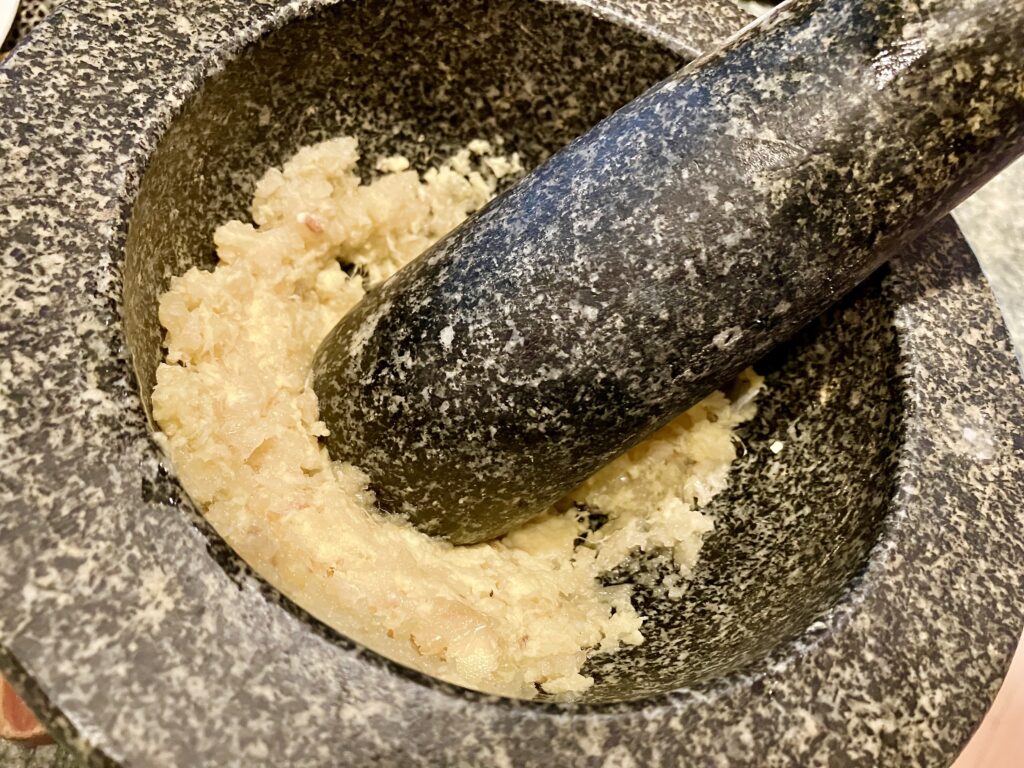
Remove the skin from the chicken and discard. Salt both sides, crush on lots of black pepper from a pepper mill, and then sprinkle paprika onto the inner side of each thigh. Set aside.
Gently heat the saffron in a small pan over low heat until slightly toasty and then remove from heat. When cooled, crush the saffron with your fingers.
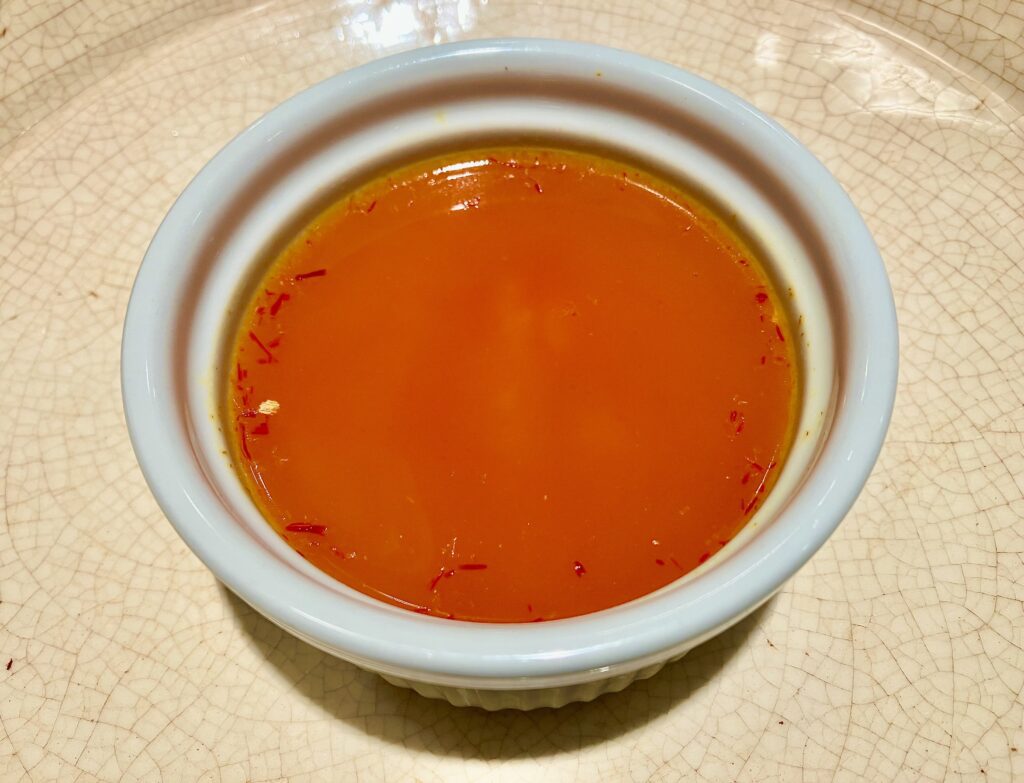
Over medium heat, warm 1 cup of chicken broth and stir in the crushed saffron. Remove from heat and set aside. This beautiful orange-red liquid will infuse into all the ingredients, throughout the entire Tagine.
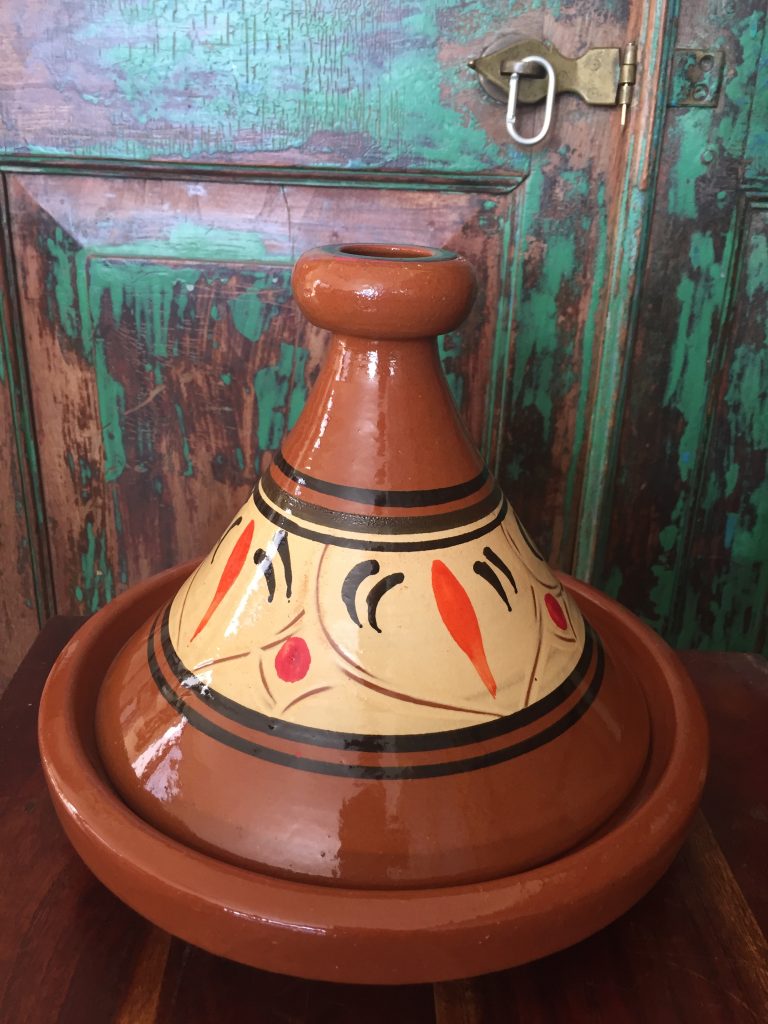
Traditional equipment
2 Tagine clay vessels (please make sure they are lead free and safe for cooking) and 2 cast iron pans, 12 inches each.
Note: Tagine meals are very flexible, so you can easily add other ingredients that are traditional to Morocco. Also, if you don’t have a Tagine, you can use a cast iron Dutch oven. For the prep work and the cooking, you need to allow two to three hours before the Tagine can be served. This recipe is for eight people, so we use two Tagines. If you are cooking for less, or only have one Tagine, use half of all the ingredients in the recipe.
Cooking
Using the two cast iron pans simultaneously, melt half the butter/olive oil/duck fat and saute´ the carrots with medium/high flame, until they are hard seared but not soft, (about 12 to 15 minutes). Remove and set aside.

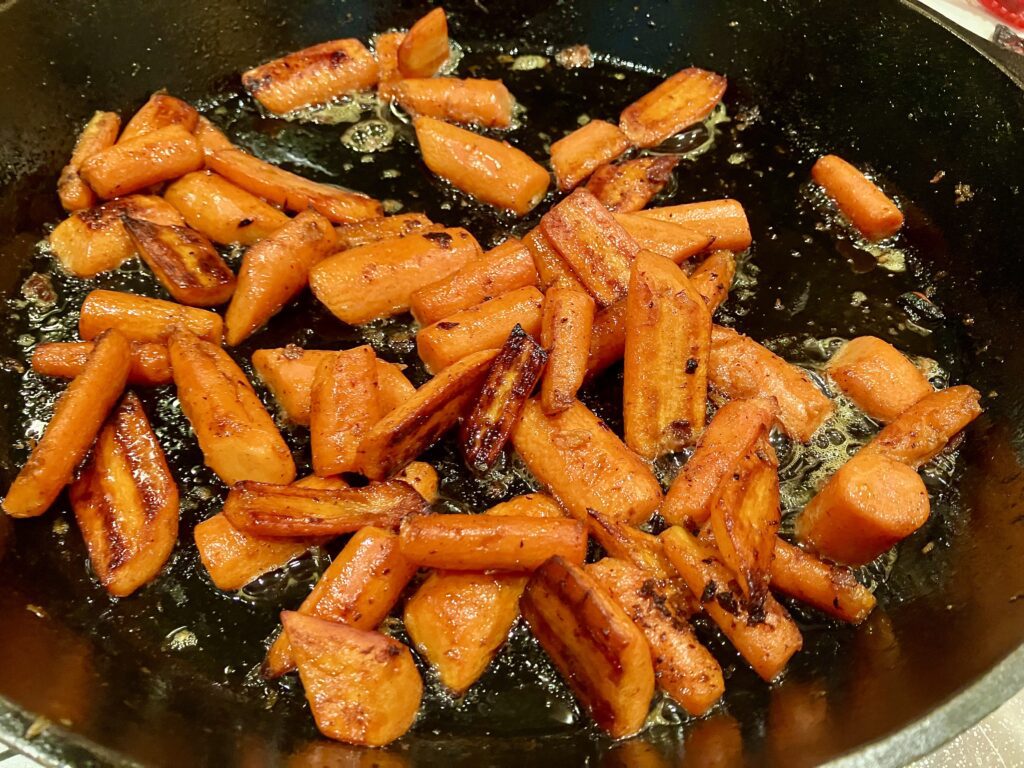
Add the onions to the same hot cast iron pans and fry until they are opaque. Add the remaining olive oil/butter/duck fat and fry the chicken with the opaque onions, starting with the paprika side down, which enhances the flavors in the oils. Fry at medium to high flame until both sides are seared.
Add the garlic/ginger paste and continue to stir the chicken so it doesn’t stick and until it’s coated and shows a deep patina color.
Add the olives and stir them under the chicken. Fry for about two minutes, then add the cup of chicken broth infused with saffron evenly to both cast iron pans equally. Reduce the heat and allow the pans to bubble gently for a few minutes and then turn off the heat.
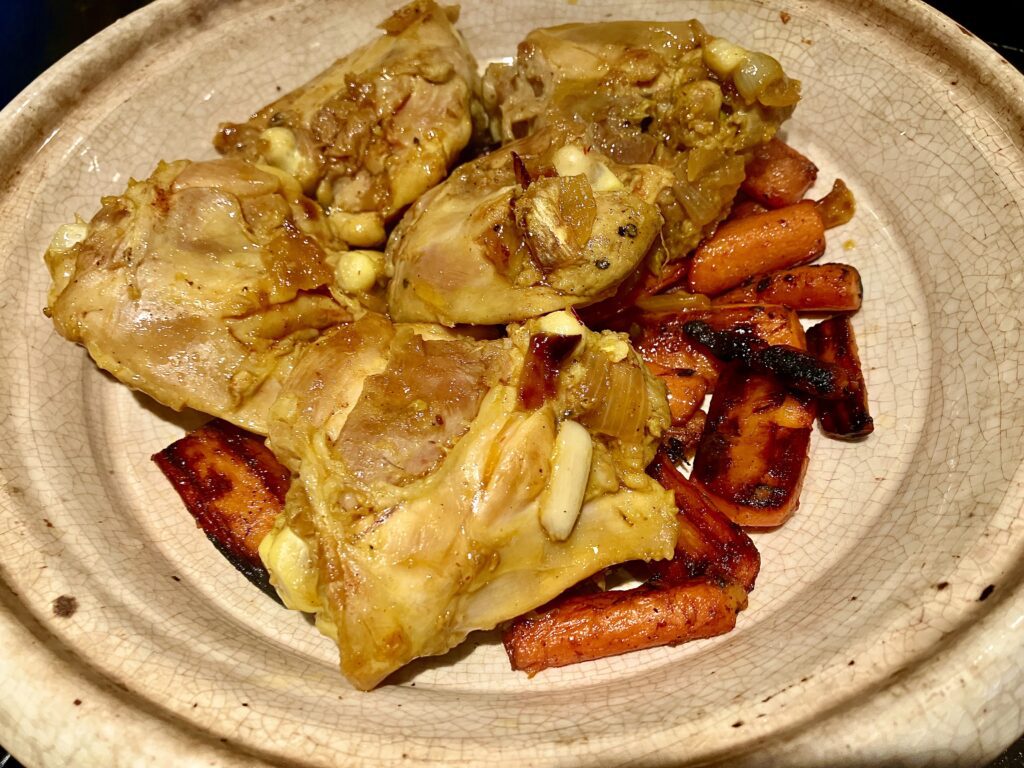
In both Tagines, place the carrots on the bottom and add the chicken/onion/olive mixture equally. Add 1/2 cup of chicken broth to both Tagines.
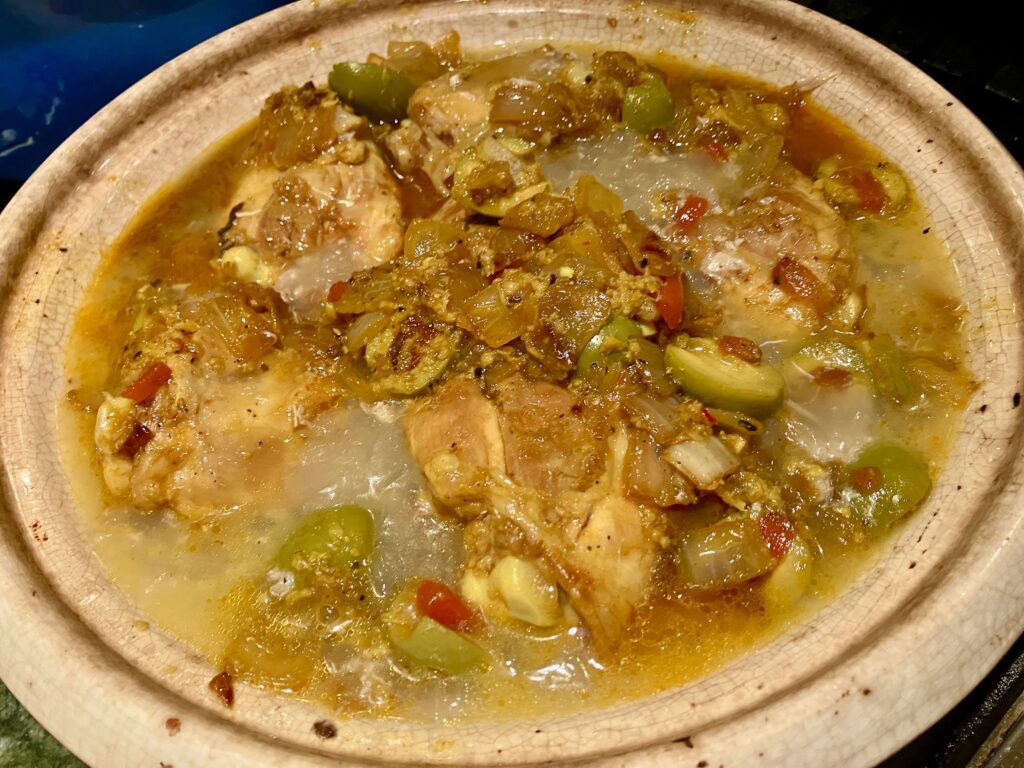
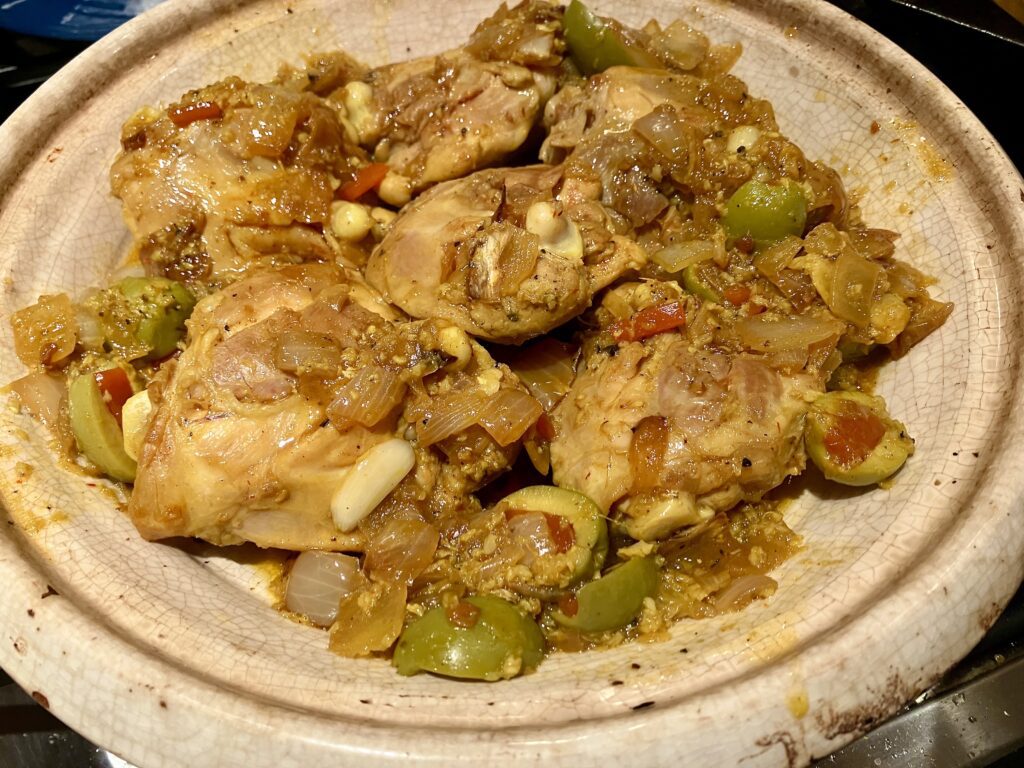
Add 20 sprigs of both Italian parsley and cilantro on top of the chicken. Cover with the conical lid, and place both Tagines into a COLD oven. DO NOT PREHEAT THE OVEN, it may crack the Tagines. Set the temperature to 400 degrees and bake for 1 hour once the oven achieves that temperature.
While the Tagines are bubbling in the oven, place the liquid from the artichoke cans into a 12 inch pan and bring to a simmer. Add the liqueur from the preserved lemons, along with the pulp from the lemons. Set aside the lemon skins. Add the baby artichokes and the last two cups of the chicken broth and reduce the liquid by a half.

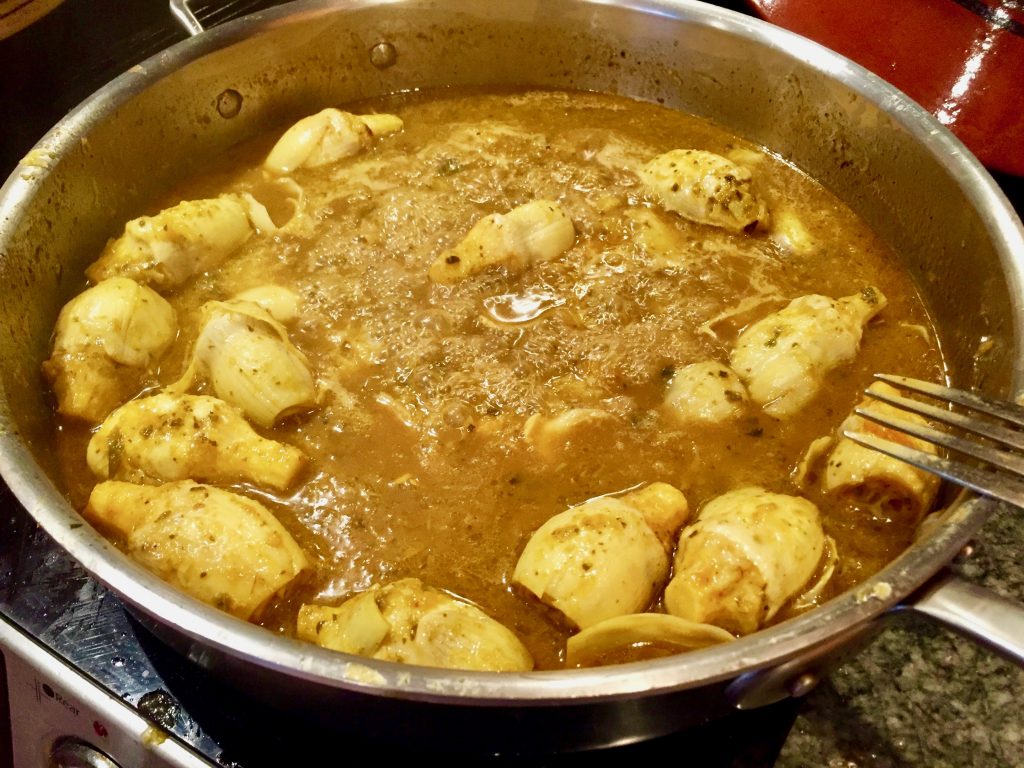
After an hour in the 400 degree oven, remove the Tagines.

Carefully add their liquids to the reduced artichoke preserved lemon sauce. Discard the herbs and return the Tagines to the oven, which has been turned off.

Add the poblano paste and the juice of the fresh lemon to the reduced sauce and allow to bubble and marry the flavors. Add the sugar or mirin.

Combine the chicken, olives, carrots and the finished reduced sauce in a large Moroccan bowl and add the delicate preserved lemon skins.
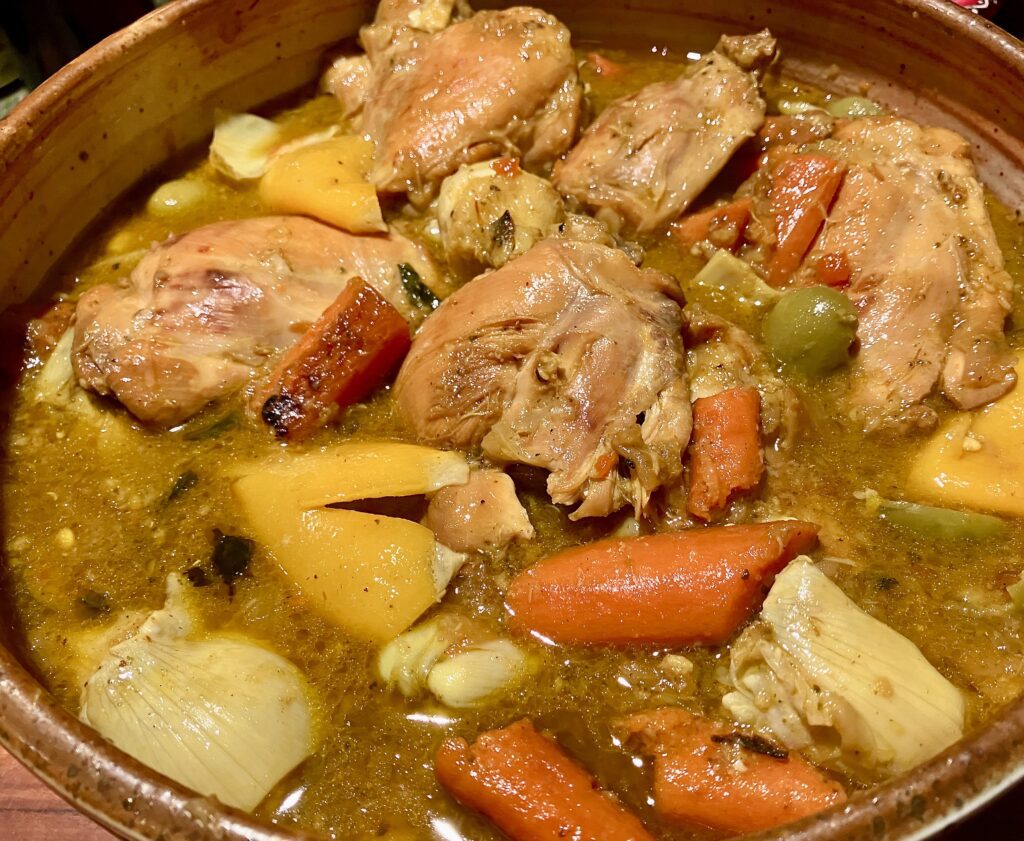
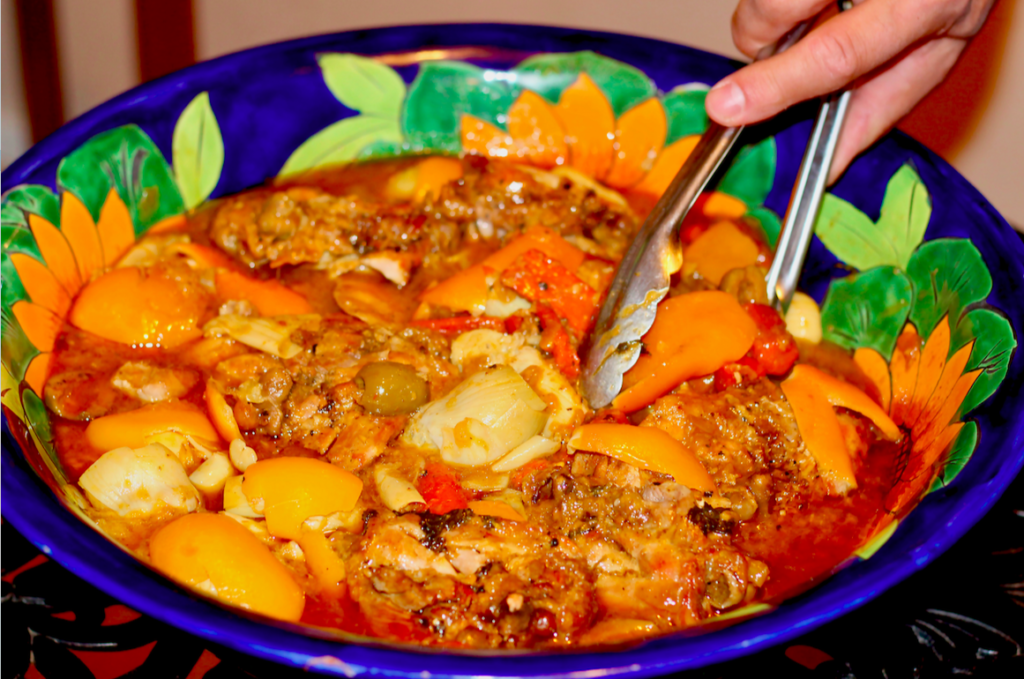
Serve with fluffy couscous. It will transport you to back to Morocco, and make you feel as if you were strolling through the spice market of the Kasbah in Casablanca.
The Couscous
The cooking of couscous is an art form, and to do it properly, as we have learned to do from cooks in Morocco, takes far more time that is practical for this meal. (There are entire elaborate cooking pots made in Morocco just to steam the couscous. They would be appalled at our boiled couscous from store bought boxes.) The crucial element is to keep the couscous grains separate and slightly under-done, so each grain falls away from the other, and they are fluffy and aromatic. In a medium saucepan bring 1 3/4 cups of liquid, half water and half chicken broth, with 1 star anise, 1 tablespoon of butter, and half a teaspoon of salt, to a boil.
Turn OFF the heat and add the couscous. Set the timer for 4 minutes and 50 seconds. When the timer goes off, remove the couscous from the pan by scraping it out with a large fork, layer by layer, into a large platter. Using the fork, quickly separate the grain from each other, allowing them to cool as fast as possible. When all the couscous is separated and cooled and fluffy, they can be served under the Chicken Tagine on individual plates.
